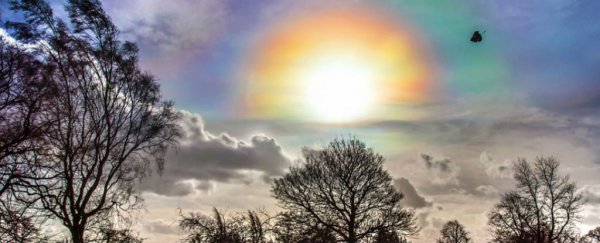A rare phenomenon known as cloud iridescence has appeared in the sky above West Yorkshire in England, leaving behind big, bright semicircles of rainbow light, and streaks of blues, greens, purples, and fiery oranges in its wake.
Nicknamed 'fire rainbows', these stunning light patterns are neither fire nor technically even rainbows, and bringing together all the conditions required to make them appear is no small feat. The only way a fire rainbow can form is if the Sun is positioned higher than 58° above the horizon, and its light is passing through high-level cirrus clouds made of hexagonal ice crystals, at an altitude of more than 6 km.
Because the Sun has to be at such an exact angle to make the colours visible, fire rainbows are only really seen at particular altitudes at certain times of the year, making them a far more common occurrence in the US than in the UK towns of Ambleside, Cumbria, and Normanton, where they've just been spotted. Your best chance of seeing one is somewhere near the equator at noon in mid-Summer.
"For example, in London, the Sun is only high enough for 140 hours between mid-May and late July. While in Los Angeles, the Sun is higher than 58 degrees for 670 hours between late March and late September," Amusing Plant reports.
So why aren't fire rainbows technically rainbows? It has to do with the specific way the Sun's light interacts with the ice crystals in clouds. While plain old rainbows are formed thanks to light being refracted (or bent) as it passes through water droplets, and then reflected back in various colour wavelengths, fire rainbows are formed thanks to the process of light diffraction.
"Diffraction … involves light waves being scattered into a ring-like pattern," says Live Science. "As with other iridescent objects, like peacock feathers, the colour changes depending upon one's position relative to the Sun and the object."
Here are more photos of the fire rainbows that lit up the sky in Britain, tweeted by photographer Michiko Smith (click on the tweets to see bigger versions):
@KeeleyDonovan @kcrewders @BBCLookNorth #MotherOfPearl clouds over #Normanton yesterday. #beautiful pic.twitter.com/HD1hBI7h7C
— Michiko Smith (@Michiko_Smith) February 2, 2016
@BBCLeeds #IridescentClouds #Normanton, West Yorks. #proudtobeyorkshire pic.twitter.com/UHOvMaq0Lj
— Michiko Smith (@Michiko_Smith) February 1, 2016
